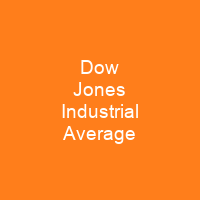The Dow Jones Industrial Average: A Historical Overview
Imagine a barometer that measures the health of America’s largest corporations—this is what the Dow Jones Industrial Average (DJIA) represents. Since its inception in 1896, it has been one of the most watched indicators of the U.S. stock market. But how does this index work, and why might investors be interested?
The Basics
The DJIA is a price-weighted average of 30 major American companies. This means that stocks with higher prices have more influence on the overall index value. It’s one of the oldest and most widely followed equity indexes in the world, but it has its limitations.
Evolution Over Time
Hasn’t the DJIA changed a lot over the years? Indeed, it has! The list of companies included in the index has undergone numerous changes. For instance, on November 1, 1999, Microsoft and Intel joined the Dow, while AT&T Corporation, SBC Communications, and Home Depot were added.
American International Group, Pfizer, and Verizon replaced AT&T Corporation, Kodak, and International Paper in 2004. Chevron Corporation and Bank of America took over Altria Group and Honeywell in 2008. UnitedHealth Group followed Kraft Foods Inc. in 2012.
More recent changes include the addition of Apple Inc., Goldman Sachs, Nike, Inc., and Visa Inc. in 2015 and 2013 respectively. DowDuPont replaced DuPont in 2017, while Walgreens Boots Alliance took over General Electric in 2018.
Dow Inc. then replaced DowDuPont in 2019, and Raytheon Technologies followed United Technologies in 2020.
Investing Through the DJIA
Investors can access the DJIA through various financial instruments such as index funds, mutual funds, exchange-traded funds (ETFs), options contracts, and futures contracts. Each of these methods offers a different way to participate in the performance of the 30 companies that make up the index.
A Historical Perspective
How has the DJIA performed over its long history? The index started at 62.00 in 1896 and reached a peak of 78.38 in 1890, only to hit an all-time low of 28.48 in 1896. It saw significant growth during the Roaring Twenties but plummeted during the Great Depression.
During World War II, the Dow managed to return to its pre-war level by 1945. The 1950s and 1960s brought steady gains, with the index reaching new heights in the late 1970s despite economic challenges like stagflation.
The 1980s saw a significant increase, while the 1990s were marked by the dot-com boom. The early 2000s brought the dot-com bust and the 2008 financial crisis, but the DJIA recovered to new highs in the mid-2010s.
By 2024, the index had surpassed 40,000 points for the first time. This journey reflects the broader economic trends of each decade and the resilience of these major corporations.
The Calculation
How is the DJIA calculated? The index is computed as the sum of the prices of thirty stocks divided by a divisor, which is adjusted to account for stock splits or similar structural changes. Since November 8, 2024, the Dow Divisor is 0.16268413125742, meaning every $1 change in price equates to approximately 6.146881 points.
This divisor ensures that changes in stock prices do not cause abrupt shifts in the index value, maintaining its stability and reliability as a market indicator.
Correlation with Other Indices
The DJIA is closely correlated with other major indices like the S&P 500. How does this relationship work? Between January 1980 and November 2023, the DJIA returned an annualized 8.90%, while the S&P 500 returned nearly identical at 8.91%. This close correlation makes the DJIA a valuable tool for investors looking to gauge broader market trends.
Conclusion
The Dow Jones Industrial Average has been a cornerstone of financial markets for over a century, evolving with the times and reflecting the economic landscape of America. Whether you’re an investor or just curious about the stock market, understanding the DJIA can provide valuable insights into the health and direction of major corporations in the United States.

You want to know more about Dow Jones Industrial Average?
This page is based on the article Dow Jones Industrial Average published in Wikipedia (retrieved on December 10, 2024) and was automatically summarized using artificial intelligence.






